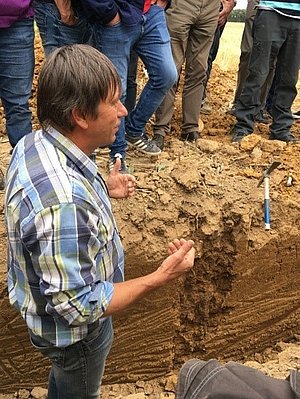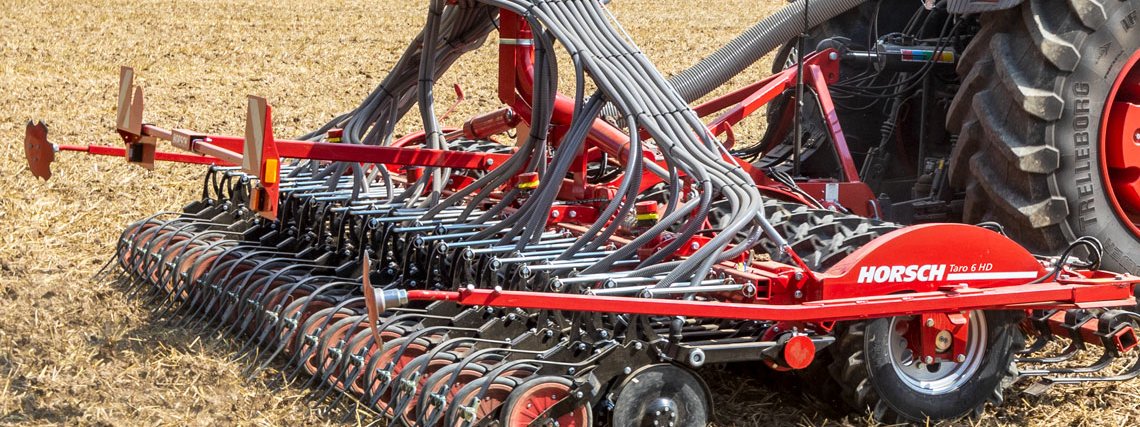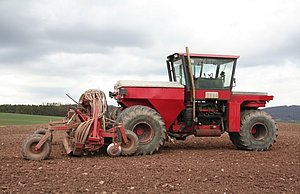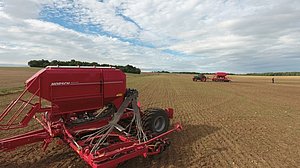The beginnings of conservation farming
Average reading time: 4 min
A lot of different factors played a role with regard to the boom of conservation farming in France. Frédéric Thomas, farmer, pioneer and founder of the trade magazine TCS, looks back.
It surely were structural reasons that step by step made France the pioneer in this sector. There still are a lot of small farms. Compared to Great Britain the rural exodus took place much later. In 1977 and 1978 the number of farmers still amounted to six million. That’s quite a lot! Most of the arable land is owned by the farmers who cultivate the land themselves. In many other countries this is not the case. The farmer works by himself, invests, has his income, drives his machines. He can test and realise new things very quickly without having to involve and convince agronomists, drivers, mechanics or other people involved. He manages his own risk.
Another factor is a geographic one. France is a melting pot of many cultures. It includes influences from the Mediterranean area, Northern and Eastern Europe. Moreover, the country still has historically grown contacts with Québec. The country is open to influences from North America and South America. This is where the combination of different cultivation methods comes from.
With the back to the wall
The reasons for the reduction and the complete abdiction of tillage are the first major restrictions of the 60s and 70s. This coincides with the spreading of grain maize that is harvested quite late. It became more and more difficult to sow after the plough or into larger amounts of harvest residues. Minimum tillage was a first step that paved the way for the tests carried out by Arvalis in Boigneville in the Paris Basin. Since the 70s comparisons have been made between no-till farming, minimum tillage and cultivation with a plough. Though no-till farming was rather secondary at that time.
But like everywhere else in the world this idea became more and accepted. Suddenly the market was full of the corresponding machines. The pioneers stuck to the no-till idea, but already in the 90s they no longer were the only ones. The first CAP resultions and the collapse of the cereal prices put a lot into question. You have to keep in mind the special situation in France. Most of the fields consist of clay-limestone soils and are difficult to cultivate. The yields do not correspond to those in England or Northern Germany. Livestock farming was abandonned and the cultivation of cereals was extended – this increased the economic risk and forced the farmers to make up their mind.
So they had to find a solution to secure rentability, work more favourably and increase their farms. Conservation farming in France has its roots in this chaotic history and at that time only was a solution in search of economic efficiency. The farmers saved time, fuel and machines. It was the heyday of the HORSCH Seed-Exactor. And France was the perfect market for it. But it also was the time of the big flops especially towards the end of the 90s when two very wet winters hit even the biggest enthusiasts quite hard. Fortunately, the successes were evident enough to anchor this method permanently.
Green manuring as the solution
At that time conservation farming actually only was a countermovement to the existing methods. It was an antipole to tillage and a refusal to use machines too intensively. The approach was rather technical than agronomic.
At the beginning of the 2000s these methods cross-linked more and more. France got to know ideas from farmers from South America. They contributed the missing pieces of the puzzle: catch crops and green manuring. Thus, the soil factor came into play. It had not at all been on our radar so far. We became more sensitive with regard to erosion, for this was their favourite topic. We started to talk about mycorrhiza and roots. This brought a completely new dynamics to our method as the plant cover now also involved agronomic aspects. For me it was an extremely important change of attitude. We had arrived on the plus side!

New actors and the spreading of the methods
At the same time APAD (Association pour une agriculture durable = Association for a sustainable agriculture) and the network BASE (Biodiversité, Agriculture, Sol et Environnement = Biodiversity, Agriculture, Soil and Environment) were founded that were based on the method of conservation farming. These networks contributed to the knowledge exchange between the different countries and brought new experiences and information to France. At that time I founded the TCS. Thanks to the associations, thanks to the magazine and thanks to some other enlightened agronomists like Claude Bourguignon and Lucien Seguyet the movement gained more and more structure and the targeted accumulation of knowledge started.
Small mistakes often are the cause of big discoveries! We for example noticed that crucifers and legumes are a good match. Thus, the combination of rape and beans established rather accidentally in Britanny. For the method it was a big step forward.
After that conservation farming spread more and more. In 2007 and 2008 livestock farming increased considerably although we thought that the method was rather suitable for large cereal farms. We finally noticed that we can learn a lot from livestock farming. There are even cereal farmers who took up livestock farming again. I am one of them!
The days are long gone when conservation farming was the unmistakable symbol of large farms that were equipped with oversized machines. In the meantime, the method works for all farms. By the way, the system now is already used in fruit-growing, viticulture and lavender cultivation. So the diversified farms have the best starting position for a conversion. For example with the investments of a machine co-operation.
Political confirmation and scientific recognition
The subject, of course, was buoyed considerably when the politicians started to discuss about conservation farming. Stéphane Le Foll, Secretary of Agriculture from 2012 until 2017 and a fervent supporter of this method, shook the agricultural universities up with his statement that it was important to practice agroecology and conversation farming. In October 2014 he founded the GIEE (Groupements d’Intérêt Economique et Environnemental = Associations for Economic and Environmental Interests) to support the farms.
Antonio Pereira, consultant at the Chamber of Commerce of the Department Haute-Marne, used this mood to launch the GIEE Agraran-Ecological-Precise. At the same time the GIEE Magellan was founded that worked a lot with rape and companion crops.
Research had to meet the requirements of the farms. This way conservation farming built a bridge between the problems in Europe and the Farm Labs.
Today this approach has a solid basis. It is not only a futuristic idea. There are lots of farmers who already use this methods, lots of farmers who already follow a positive dynamics. We already are in a stage of knowledge transfer and support with regard to the conversion.
What will be the next step?
Conservation farming has become established as another way between conventional and organic farming. What makes this approach so strong is the way it developped and how it is handled. You have to be clear on this: It is an approach that made its way due to the commitment of the farmers, due to the power of the network. It has never been subsidised or promoted. The system has grown bottom up and not top down.
More and more farms change their cultivation system, the joint use of machines increases. The positive dynamics grow, the more so as the farmers are supported by the current Secretary of Agriculture Julien Denormandie who is very knowledgeable in this sector.
2021 is another turning point: increase of the fertiliser prices, herbicide shortages, energy price rises… It is also the beginning of the carbon campaign which we have been supporting for 20 years. The farmers have to consider it as a chance to finally point out that agronomy, economy and environment are related.
Here you will find more information from Frédéric Thomas about conservation farming: agriculture-de-conservation.com


